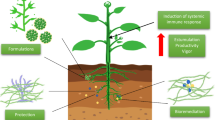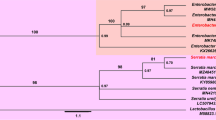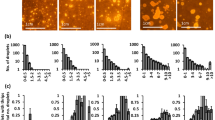Abstract
Tanzanian strains of Tribolium castaneum (Herbst), Gnatocerus maxillosus (F.), Sitophilus oryzae (L.) and Sitophilus zeamais Motschulsky were confined to maize grain treated with a dilute dust of permethrin at the rates of 1.5, 3.0 and 6.0 ppm active ingredient. The adult mortality and resulting F1 generation were recorded. G. maxillosus was very susceptible to the insecticide and even the lowest dose brought complete control. T. castaneum adults survived all treatments but few F1 were produced. Adult survival of s. oryzae and S. zeamais was progressively reduced by increasing dosage, although S. zeamais was much less susceptible to the treatment than S. oryzae.
The repellency of grain, treated with 3.0 ppm permethrin, to S. oryzae, S. zeamais and T. castaneum was tested in a simple choice chamber. Neither male nor female T. castaneum were repelled but significantly fewer eggs were laid on treated grain. For both Sitophilus spp there was no significant difference between the numbers of females or eggs observed on treated or untreated grain, but males were repelled from permethrin.
The importance of these results is discussed in relation to a recent recommendation that the treatment of shelled grain with 3.0 ppm permethrin should be adopted in Tanzania in order to control Prostephanus truncatus (Horn), a new and serious storage pest.
Résumé
Les souches tanzaniennes de Tribolium castaneum (Herbst), Gnatocerus maxillosus (F.), Sitophilus oryzae (L.) et Sitophilus zeamais Motschulsky ont été restreintes aux graines de mais traité au moyen de perméthrine pulvérulente diluée à des taux d’ingrédient actif de 1,5, 3,0 et 6,0 ppm. II a été enregistré la mortalité adulte ainsi que la génération F1 en résultant. II a été observe que G. maxillosus était très sensible à l’insecticide et même la dose la plus faible permettait de la maîtriser totalement. Les adultes de T. castaneum ont survécu à tous les traitements, toutefois rare a été la génération F1. La survie des adultes de S. oryzae et S. zeamais a été progressivement réduite en augmentant la dose, bien qu’il ait été observe que S. zeamais soit beaucoup moins sensible au traitement que S. oryzae.
II a été mis à l’essai, dans une simple chambre de sélection, le caractère insectifuge des graines à S. oryzae, S. zeamais et T. castaneum traitées au moyen d’une dose de 3,0 ppm de perméthrine. Ni les mâles, ni les femelles T. castaneum n’ont été repoussés, mais il a été pondu un nombre beaucoup moins important d’oeufs sur les graines traitées. En ce qui concerne les deux espèces de Sitophilus, il n’a pas été observé d’écart significatif entre le nombre des femelles ou des oeufs sur les graines traitées ou non traitées, mais la perméthrine a repoussé les mâles.
II est étudié l’importance de ces résultats relativement à une recommandation récente indiquant que le traitement des graines décortiquées, au moyen de perméthrine à 3,0 ppm, soit adopté en Tanzanie afin de lutter contre Prostephanus truncatus (Horn), constituant un nuisible nouveau et sérieux des installations d’entreposage.
Similar content being viewed by others
References
Adesuyi S. A. (1982) Field trials with permethrin dust for the control of insect infestation on stored maize in Southern Nigeria. J. stored Prod. Res. 18, 125–130.
Braun J. V. and Braun J. D. (1958) A simplified method of preparing solutions of glycerol and water for humidity control. Corrosion 14, 117–118.
Chadwick P. R. (1962) Studies on the sub-lethal effects of pyrethrins on the grain weevil, Calaridra oryzae L. Pyrethrum Post 6, 20–26.
Evans N. J. (1985) The effectiveness of various insecticides of some resistant insect pests of stored products from Uganda. J. stored Prod. Res. 21, 105–109.
Frankenfeld J. C. (1948) Staining methods for detecting weevil infestation in grain. USDA Bureau of Entomology Publication No. ET-256.
Golob P. (1984) Prostephanus truncatus (Horn), the Larger Grain Borer, in East Africa: the development of a control strategy. In Proceedings of the 3rd International Working Conference on Stored Products Entomology, Manhattan, Kansas, U.S.A., 1983, pp. 711–721. Kansas State University, Manhattan, Kansas.
Golob P., Changjaroen P., Ali M. A. and Cox J. (1985) Susceptibility of Prostephanus truncatus to insecticides. J. stored Prod. Res. 21, 141–150.
Halstead D. G. H. (1963) External sex differences in stored products Coleoptera. Bull. ent. Res. 54, 119–134.
Hodges R. J., Dunstan W. R., Magazini I. and Golob P. (1983). An outbreak of Prostephanus truncatus (Horn) (Coleoptera: Bostrichidae) in East Africa. Protect. Ecol. 5, 183–194.
Hodges R. J., Meik J. and Denton H. (1985) Infestation of dried cassava (Manihot esculenta Crantz) by Prostephanus truncatus (Horn) (Coleoptera: Bostrichidae). J. stored Prod. Res. 21, 73–77.
Ishaaya I., Elsner A., Ascher K. R. S. and Casida J. E. (1983) Synthetic pyrethroids: toxicity and synergism on dietary exposure to Tribolium castaneum (Herbst) larvae. Pest. Sci. 14, 367–372.
Maceljski M. and Koranic Z. (1973) Contribution to the morphology and ecology of Sitophilus zeamais Motsch. in Yugoslavia. J. stored Prod. Res. 9, 225–234.
Pearson J. A. (1982) The sublethal effects of permethrin on Tribolium castaneum. M. Phil, thesis. University of Cambridge. p. 93.
Pranata R. I., Haines C. P., Roesli R. and Sunjaya (1983) Dust admixture treatment with permethrin for the protection of rough rice and milled rice. In Maintaining Good Grain Quality: Proceedings of the 6th Annual Workshop on Grain Post-Harvest Technology (Edited by Teter N. C., Semple R. L. and Frio A. S.).
Zettler J. L. and Jones R. D. (1977) Toxicity of seven insecticides to malathion-resistant red-flour beetles. J. econ. Ent. 70, 536–538.
Author information
Authors and Affiliations
Rights and permissions
About this article
Cite this article
Hodges, R.J., Meik, J. Lethal and Sublethal Effects of Permethrin on Tanzanian Strains of Tribolium Castaneum (Herbst), Gnatocerus Maxillosus (F.), Sitophilus Oryzae (L.) and Sitophilus Zeamais Motschulsky. Int J Trop Insect Sci 7, 533–537 (1986). https://doi.org/10.1017/S1742758400009796
Received:
Revised:
Published:
Issue Date:
DOI: https://doi.org/10.1017/S1742758400009796
Key Words
- Tribolium castaneum
- Gnatocerus maxillosus
- Sitophilus zeamais
- Sitophilus oryzae
- storage pests
- permethrin
- sublethal effects
- repellency




